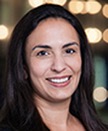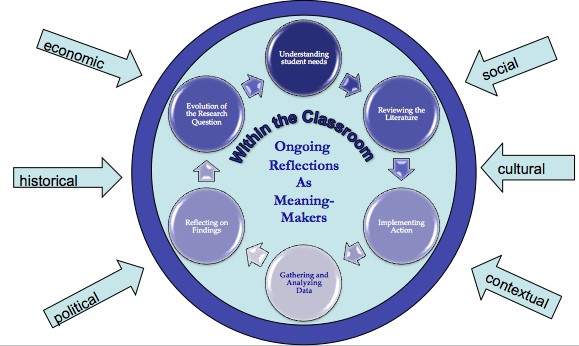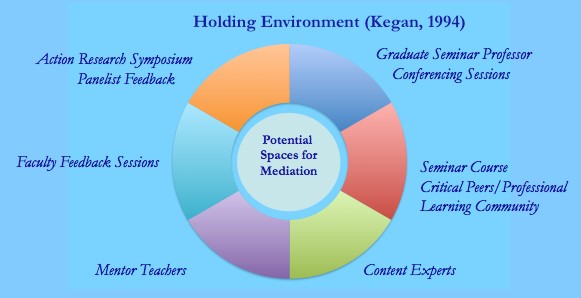 |
As part of the process of learning to teach and teaching to
learn, our TESOL teacher candidates engage in the development of their
identity from that of a student teacher to a professional educator
through the culminating practicum course where they conduct their
research study. They begin to see that they are central to the
meaning-making process, where they construct meaning and make sense of
their knowledge and experiences as they interact with the broader
contexts, which influence the practice of learning and teaching
(Kumaravadivelu, 2012). Teachers begin to realize that they are not only
enacting what has been transmitted to them, but also taking an active
role in the knowledge generation based on their learning from their
instructional practice. They also begin to understand that they need to
tailor their methods and strategies to suit their students’ individual
and collective needs. Essentially, this shift in identity is from
acquiring pedagogies and practices and employing them directly in the
classroom, to considering the appropriateness or effectiveness of these
pedagogies in light of their students, their classroom context, and the
multitude of external factors. One opportunity provided through our
program, where students can begin to make sense about what it means to
teach students in their particular contexts, is through the cyclical
opportunities provided by engaging in the action research process with
embedded reflective opportunities. We believe that action research is a
cognitively and emotionally demanding task, but a powerful tool for
potentially improving instructional practice.
Figure 1. Shifting identities from student teachers to professional educators

Unpacking Reflective Practice for Teacher Transformation
The wordsreflection, reflective practice, reflective
thinking, reflective judgment, reflexivity, and reflective learning are variations of terms that are
often used in teacher development literature as playing a central role
in teacher transformation (Kember et al., 1999; Mezirow, 1991; Schön,
1990).
Teacher transformation is often referred to as the goal for
teacher education programs, but what this means and how to get our
candidates to this goal remains unclear. Kumaravadivelu (2012) calls for
a reconceptualization of language teacher education in this postmethods
and posttransmission era, where he emphasizes the role of teacher
transformation. This transformation is believed to be achieved by
shifting our teacher candidates to the center of the meaning-making
process and empowering them to mediate their own praxis, analyzing the
theories in their practice and, in turn, having their practice influence
their theories about what it means to teach and learn in their given
contexts.
Fieldwork experiences and practitioner research (Burns, 2010)
have been proposed as tools that support such transformation because of
the reflective opportunities embedded within these experiences (e.g.,
observing, debriefing, journaling, micro-teaching).
But What Does Transformative Learning Really Mean?
According to Mezirow (2003), “Transformative learning is
learning that transforms problematic frames of reference—sets of fixed
assumptions and expectations (habits of mind, meaning perspectives,
mindsets)—to make them more inclusive, discriminating (discernment),
open, reflective, and emotionally able to change” (pp. 58–59).
Take the following riddle for example. A man and his son are in
a terrible accident and are rushed to the hospital in critical
condition. The doctor looks at the boy and exclaims, "I can't operate on
this boy. He's my son!" How could this be?
Most people are often perplexed by this riddle, until their own
assumptions and frames of reference are confronted. The assumption is
often the relationship between gender and profession, where a doctor is
associated with “man.” However, in this case, the doctor is a mother.
Perhaps we might consider that this could have also been a stepfather or
a second father from a two-father home. The reader may have considered
other possibilities as well.
Likewise, through engaging in research, particularly action
research, our candidates are often confronted with a sense of cognitive
dissonance when what they are doing with their students is not leading
to student learning as revealed by what we require, which is the
triangulation of data. We require our candidates to include, at minimum,
three data sets so that their inclination, intuition, assumption, and
proclivity often collected in their teaching journals can be
corroborated by objective counterparts, such as student perceptions,
test measures, and so on. Candidates often come up with project ideas
that they have a certain attachment to, and it is often this attachment
that causes severe disenchantment for them. For example, one candidate
wanted to employ games to teach vocabulary, where it became clear that
her inherent assumption was that the use of games will lead to increase
in vocabulary knowledge and use (however, “games,” “vocabulary
knowledge,” and “vocabulary use” are operationalized for her study). The
results of this study could veer in many directions: (a) vocabulary
knowledge and use increased, (b) vocabulary knowledge and use stayed the
same, (c) vocabulary knowledge and use decreased, (d) vocabulary
knowledge increased, but use decreased, and so on. In addition to a
multitude of variables such as students’ previous background knowledge
and selection of vocabulary, this candidate had to begin to consider
other factors that might have influenced her finding. When she found
that their vocabulary knowledge increased, but not its usage, she
elected to try another game. However, through our discussions, she came
to an understanding that she needed to dig deeper, that it may not
necessarily be the games themselves, but the specific embedded
opportunities that the games provided that led to the results of her
study.
Transformative Learning: How Do We Break Free?
Several processes have been identified in the literature as
providing opportunities for transformative learning. Mezirow (1999)
asserts that when premise is reflected upon and questioned rather than
reflection on content or process, this can lead to transformation.
Likewise, Cranton (2006) describes the questioning of “prior habits of
the mind” (p. 23). Daloz (1999) and Daloz Parks (2000) refer to the
moment when cognitive dissonance is revealed as a “shipwreck moment,”
where Kegan and Lahey (2009) term this as an “optimal conflict” leading
to adaptive change (p. 54). In action research, this often occurs
through the deliberate mediation structures embedded in our
program.
Our Learning Community Based on Sociocultural Theory
Figure 2. Our holding environment

Sociocultural theory has its roots in the work of Vygotsky
(1978), who points out that all learning happens through social
interaction. First the learning appears in the social realm, or the
interpsychological dimension, where teachers or more capable peers
(experts) can scaffold the learning process through the co-construction
of meaning within the zone of proximal development. This learning then
moves from the social level or the interpsychological dimension to the
internal level known as the “intrapsychological category” (p. 128).
Johnson and Golombek (2011) have done considerable work around
reflective learning and teaching and describe the mediation process as
follows: “When we see/hear the same teacher interact with someone who is
more capable while accomplishing a task that is beyond her
capabilities, this creates a window through which we can see her
potential for learning and her capabilities as they are emerging. . . .
[M]ediation in this metaphoric space of potentiality is essential” (p.
6).
We have tried to embed these mediation opportunities in our
holding environment (Kegan, 1982, 1994), with the intention of providing
both support and challenge purposefully negotiated for teacher
candidates’ learning and development. The “expert” others in our program
include not only the seminar professor, but also a critical peer or two
selected from their cohort, content area experts including other
faculty members within and beyond our program, and their practicum
mentor teachers. In addition, candidates engage in feedback sessions
where faculty provide additional feedback on their presentations, prior
to the culminating research symposium where the candidates present their
final research project to a panel of TESOL and other professionals and
receive additional, invaluable feedback.
As such, our program attempts to provide multiple opportunities
for candidates to engage in the type of premise reflection necessary
for teacher transformation to help them make sense of the disconnect or
disenchantment they experience through the process. It remains unclear
what this process entails and what reflection for transformation looks
like given the different knowledge, skills, experiences, and
dispositions students bring with them to the program. As such, a study
is now underway to ascertain how candidates engage in such reflective
practice through a systematic analysis of the mediation process embedded
in the deliberate structures we have put into place to support teacher
transformation in our program.
References
Burns, A. (2010). Doing action research in English
language teaching. New York, NY: Routledge.
Cranton, P. (2006). Understanding and promoting
transformative learning: A guide for educators of adults (2nd
ed.). San Francisco, CA: Jossey-Bass.
Daloz, L. A. (1999). Mentor: Guiding a journey of
adult learners. San Francisco, CA: Jossey-Bass.
Daloz Parks, S. (2000). Big questions, worthy dreams:
Mentoring young adults in their search for meaning, purpose, and
meaning. San Francisco, CA: Jossey-Bass.
Johnson, K. E., & Golombek, P. R. (Eds.). (2011). Research on second language teacher education: A sociocultural
perspective on professional development. New York, NY:
Routledge.
Kegan, R. (1982). The evolving self: Problem and
process in human development. Cambridge, MA: Harvard
University Press.
Kegan, R. (1994). In over our heads: The mental
demands of modern life. Cambridge, MA: Harvard University
Press.
Kegan, R., & Lahey, L. L. (2009). Immunity to
change: How to overcome it and unlock the potential and your
organization. Boston, MA: Harvard Business Press.
Kember, D., Jones, A., Loke, A., Mckay, J. Sinclair, K., Tse,
H., . . . Yeung, E. (1999). Determining the level of reflective thinking
from students’ written journals using a coding scheme based on the work
of Mezirow. International Journal of Lifelong Education,
18(1), 18–30.
Kumaravadivelu, B. (2012). Language teacher education
for a global society: A modular model for knowing, analyzing,
recognizing, doing, and seeing. New York, NY:
Routledge.
Mezirow, J. (1991). Transformative dimension of adult
learning. San Francisco, CA: Jossey-Bass.
Mezirow, J. (2003). Transformative learning as discourse. Journal of Transformative Education, 1(1), 58–63.
Schön, D. A. (1990). Educating the reflective
practitioner: Toward a new design for teaching and learning in the
professions. San Francisco, CA: Jossey-Bass.
Vygotsky, L. S. (1978). Mind in society: The
development of higher psychological processes. Cambridge, MA:
Harvard University Press.
Sarina Chugani Molina serves as assistant professor
and coordinator of the MEd in TESOL, Literacy, and Culture Program at
the University of San Diego. Her research interests include teaching
English as an international language and TESOL teacher development,
particularly as it relates to developing mindful, reflective
practitioners. |

